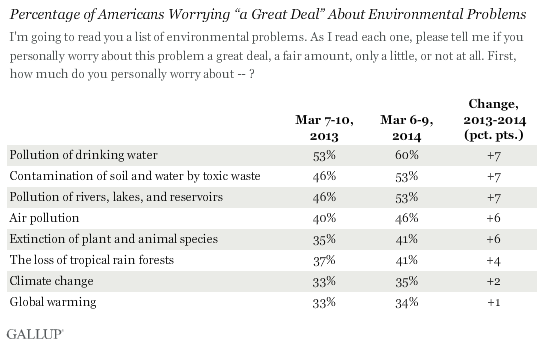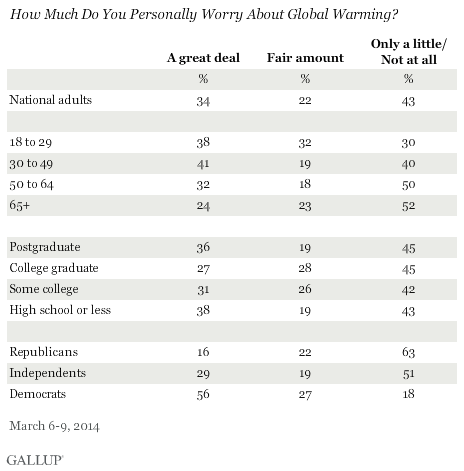Americans Show Low Levels of Concern on Global Warming,Worry about other environmental problems increasing
- Get link
- X
- Other Apps
This article is the sixth in a series that will analyze Gallup's latest March update on Americans' views onclimate change and examine how these views have changed over time. The series will explore public opinion on the severity and importance of climate change, its causes and effects, the extent of Americans' understanding of the issue, and much more.
PRINCETON, NJ -- The United Nations Intergovernmental Panel on Climate Change issued a new report this week warning of the existing and potentially severe adverse future impact of climate change, yet most Americans continue to express low levels of concern about the phenomenon. A little more than a third say they worry "a great deal" about climate change or about global warming, putting these concerns at the bottom of a list of eight environmental issues.

Americans' concerns about global warming and climate change have held steady over the past year, while concerns about other environmental threats tested by Gallup have increased. The percentage expressing a great deal of worry about pollution of drinking water, as well as contamination of soil and water by toxic waste, increased by seven percentage points. Worry about climate change and global warming, on the other hand, went up by no more than two points versus last year.
Americans' generally low level of concern about global warming compared with other environmental issues is not new; warming has generally ranked last among Americans' environmental worries each time Gallup has measured them with this question over the years. Concern about pollution of drinking water has generally been at the top of the list.
Gallup has tracked worry about global warming using this question format since 1989. The percentage of Americans expressing a great deal of worry has varied over that period, partly reflecting major global warming news events along the way. The highest levels of worry occurred in April 2000 (40%) and March 2007 (41%). On the other hand, worry reached its lowest points in October 1997 (24%), March 2004 (26%), and March 2011 (25%). The current 34% worry is essentially the same as it was in 1989.

Politics Remain Major Predictor of Worry About Global Warming
Politics remain a powerful predictor of Americans' worries about global warming, with more than half of Democrats saying they worry about it a great deal, compared with 29% of independents and 16% of Republicans. This political differentiation of global warming attitudes is not isolated; other research shows that in today's political environment, Republicans are much more likely to say that concerns about global warming are exaggerated and that warming's effects will not affect them personally in their lifetimes, and are less likely to say scientists believe global warming is occurring.
Young Americans aged 18 to 29 are more worried about global warming than older adults, particularly those 50 and older. If these young people hold on to these attitudes as they age, and if future generations of Americans hold the same levels of higher concern, then the nation's overall levels of worry about warming will rise.
Worry about global warming is not related to education in any systematic way; those with postgraduate education are no more worried than those with a high school education or less. This conforms with prior research showing that education bears little relation to Americans' believing that human activities are the cause of global warming.

Implications
A major challenge facing scientists and organizations that view global warming as a major threat to humanity is that average citizens express so little concern about the issue. Many climate change activists have attempted to raise awareness in recent years, as evidenced by the recent U.N. report. Former Vice President Al Gore has been active in raising the alarm about the potentially disastrous impact of global warming, including in a documentary and a book. But the data at the national level show that none of this has changed Americans' worry about the issue in any lasting way -- perhaps reflecting the strong counter-position taken by many conservative thought leaders, and the "Climategate" controversies.
A lack of formal education in general is clearly not a factor in Americans' failure to be more concerned about global warming; Americans who have not attended college are no less concerned than those with a college degree or postgraduate education.
Politics are important in understanding American attitudes about global warming. The issue has become highly politicized in recent years, and that polarization shows up across a number of indicators. At the core, Democrats appear to have widely accepted the warnings about global warming, and well over half today say they worry about it a great deal. On the other hand, less than 20% of Republicans worry a great deal, while almost two-thirds say they worry only a little or not at all. So long as global warming remains a politically charged issue, it will likely lag behind other environmental issues as a public concern.
Finally, pollution of drinking water is Americans' greatest environmental worry, and this shows that environmental concerns are -- understandably -- quite personal, and that worries are highest when issues have a direct effect on daily lives. Some have argued that the extreme cold spells this past winter and the drought in the West are a result of climate change, but Gallup research shows that the majority of Americans think these are normal weather variations.
The United Nations report mentions calamitous outcomes from continuing global warming that would affect the world's food supply, economies, and ways of life. If any of these possibilities materializes, they may have a distinct impact on Americans' concerns.
Survey Methods
Results for this Gallup poll are based on telephone interviews conducted March 6-9, 2014, with a random sample of 1,048 adults, aged 18 and older, living in all 50 U.S. states and the District of Columbia.
For results based on the total sample of national adults, the margin of sampling error is ±4 percentage points at the 95% confidence level.
Interviews are conducted with respondents on landline telephones and cellular phones, with interviews conducted in Spanish for respondents who are primarily Spanish-speaking. Each sample of national adults includes a minimum quota of 50% cellphone respondents and 50% landline respondents, with additional minimum quotas by time zone within region. Landline and cellular telephone numbers are selected using random-digit-dial methods. Landline respondents are chosen at random within each household on the basis of which member had the most recent birthday.
Samples are weighted to correct for unequal selection probability, nonresponse, and double coverage of landline and cell users in the two sampling frames. They are also weighted to match the national demographics of gender, age, race, Hispanic ethnicity, education, region, population density, and phone status (cellphone only/landline only/both, and cellphone mostly). Demographic weighting targets are based on the most recent Current Population Survey figures for the aged 18 and older U.S. population. Phone status targets are based on the most recent National Health Interview Survey. Population density targets are based on the most recent U.S. census. All reported margins of sampling error include the computed design effects for weighting.
In addition to sampling error, question wording and practical difficulties in conducting surveys can introduce error or bias into the findings of public opinion polls.
For more details on Gallup's polling methodology, visit www.gallup.com.
- Get link
- X
- Other Apps
Comments
Post a Comment